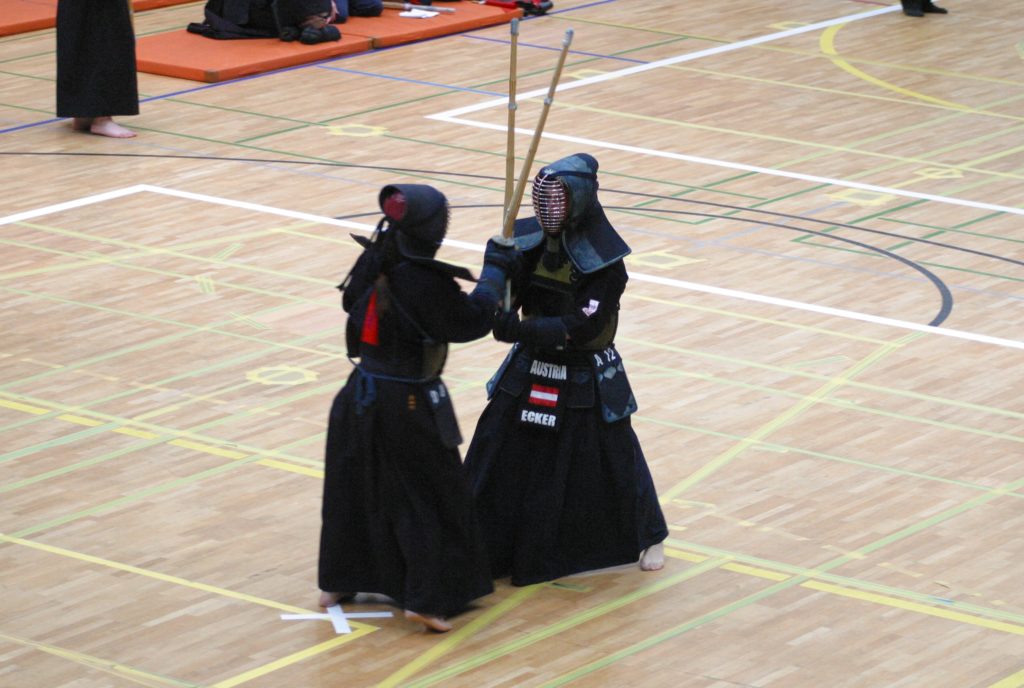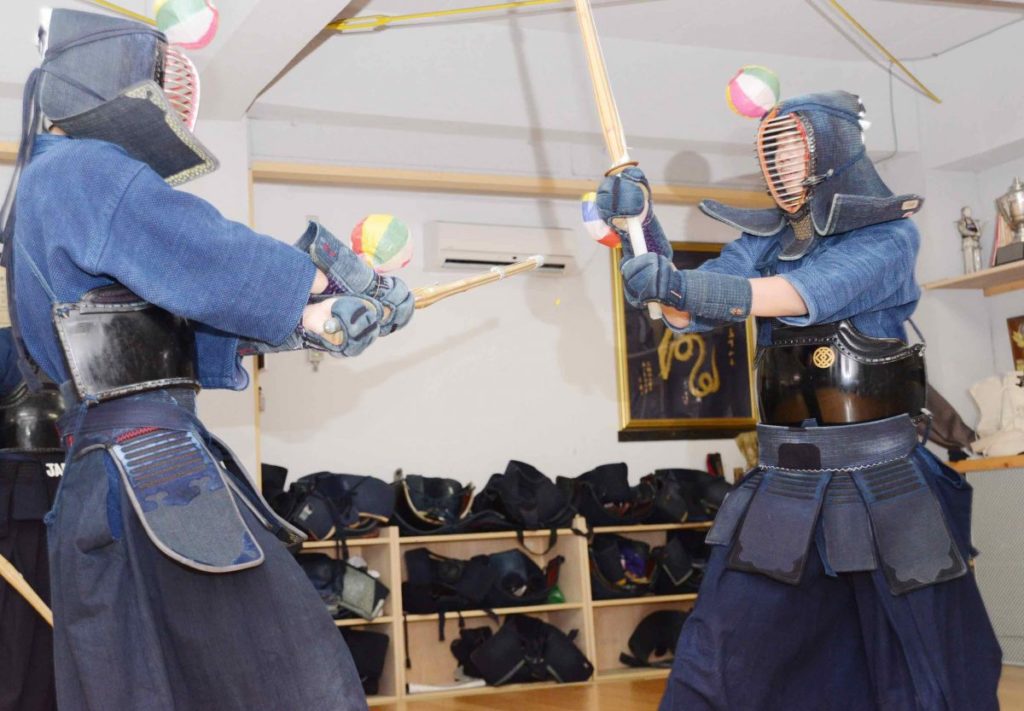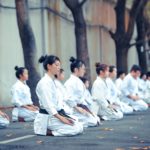Kendo is a Japanese form of fencing with two-handed bamboo swords, originally developed as a safe form of sword training for samurai warriors.
Japanese swordsmen centuries ago started kenjutsu schools where they could practice their sword skills. This evolved into modern Kendo. The use of shinai and bogu – the essential bamboo sword and armor equipment – began in the 1700s.

Today, about six million people practice Kendo worldwide, roughly a third of them in Japan.
It is an exciting martial art, both to perform and to witness. Practiced correctly, Kendo provides the thrill of combat without serious risk of injury, as the bogu armor allows for total commitment and follow-through on strikes.
Existentially, engaging in combat with a strong opponent forces Kendo practitioners (referred to as Kenshi) to confront the “four sicknesses” — fear, doubt, surprise and confusion. In the way of the Kenshi, overcoming these challenges will lead to wisdom and life lessons that can be applied anywhere.
If your passion for Kendo, for the thrill of combat, makes you want to share your skills with others, becoming a Kendo instructor might be an excellent career choice. You can make a good living while enjoying the reward of helping students unleash their full potential in this honorable and exciting martial art. Read on to find out what’s involved in becoming a Kendo instructor.
In this article you’ll learn:
- How much money you can make as a Kendo instructor
- The required training and certifications
- Professional groups to join
- Employment opportunities for Kendo instructors
- Finding clients
- Plus helpful tips
How much money can you make?
A reliable average salary for Kendo instructors is difficult to determine, as the US Bureau of Labor Statistics lumps virtually all martial arts disciplines into the same statistical category. However, the bureau reports the average salary of a karate instructor in the United States is $55,127 per year, while the average annual salary of a fencing coach is $40,089 a year, according to a GlassDoor Survey. If these two ranges are blended, the average salary for Kendo instructors would be about $47,600 annually. Running your own Kendo training program enables you to make more money, although the responsibility for finding and retaining students and covering business expenses also falls squarely on your shoulders.

Another factor impacting your income is the cost of equipment. Beginning students may be reluctant to pay for essential equipment out of their own pocket – especially if they are just trying out Kendo and are unsure of whether they’ll stick with the sport. As a result, you may need to stock a supply of Shinai (bamboo swords), Dogi (uniforms) and Bogu (training armor). As students advance and improve, you can then explain the need for them to purchase their own equipment.
Training and Certification
Numerous online and in-person training programs are available for those who want to teach Kendo. Some are even free. There are no formal licensing requirements for Kendo instructors or even certification standards. But to be credible as an instructor charging money for your knowledge and training, you’ll need to attain mastery of Kendo.

Kendo, like other martial arts, has a system of ranks. These are known as Kyu, Dan and Shogo. Kyu are the ranks that are attained leading up to the Dan, which is the equivalent of the black belt. Shogo are titles that are attained after reaching the rank 6 Dan.
Most Kendo practitioners attain the rank of 1-Dan or 2-Dan before opening their own dojo. It’s best to do your own research on training programs available online and in consultation with one or more Kendo masters who can offer their insights and possibly build a custom training plan to work with you.
Some of what you’ll learn in training:
- Teaching swordwork
- Demonstrating the Fumikomi-ashi, the unique stomping step forward when attacking opponents
- How to evaluate a Kendo student’s needs, personality, skill level, motivation and challenges.
- Making corrections in technique and style while fostering a positive learning experience
- Demonstrate Kendo techniques properly
- Teach at the students’ level
- The importance of reserving time in each class for students to experiment
- Basic business skills associated with running a Kendo training program
Professional Groups to Join
When you want to show prospective students and employers that you are serious about your career, joining a professional association devoted to Kendo is a tried-and-true way of making an impression. Benefits of getting involved with a professional group include networking with other members (who can offer job tips), access to continuing education and training, competitions and being part of a group that shares your passion.

Committee National of Kendo Arts is an association with a mission “to spread the word about this excellent Japanese martial art and sport that is growing in popularity around the world, among men and women.” Contact them through this form.
The All United States Kendo Federation (AUSKF) is a non-profit umbrella organization supporting the regional Kendo member federations. Register here for membership. The federation’s work includes:
- Organizing national tournaments
- Training a U.S. team for international competition
- Organizing promotional examination opportunities for higher ranks
- Coordinating with the International Kendo Federation (FIK).
- Providing the member federations with support programs to promote kendo in their region with guest instructors, examiners, and arranging for seminars to be given by expert sensei from other countries.
The Martial Arts Teachers Association offers training and certification for instructors, plus deep resources for learning how to run a profitable martial arts studio, as well as access to affordable insurance plans. Membership is $37 a month or $199 for a full year paid in advance.
The World Wide Martial Arts Association is a non-profit organization that provides instruction to members, hosts training camps, supports coaches and students, and publishes educational materials. The USMAA is a large governing body that works to spread the values and high-quality examination, testing, and instruction standards..
Employment
You’ll find job openings for Kendo instructors at martial arts studios, public recreation centers, the YMCA, and larger gyms with extensive fitness programs.

Before applying for jobs, make copies of your resume. You’ll need printed copies as well as a resume for online distribution. For resumes going out by email, the best way to attach documents to your email is by creating .pdf files with Adobe Acrobat. These types of files are considered safe to send and are much less likely to trigger a spam alert in the recipient’s mailbox. Always send attachments as .pdf files and you improve the odds that your online correspondence reaches a real person, not a spam folder.
Also make photocopies of all your professional certifications and memberships in Kendo organizations. These credentials set you apart from competitors for the same job, and prospective employers are more likely to pull your application to the top of the pile when deciding who to interview for the position. Competition is fierce – on and off the Kendo mat – so you may as well take advantage of every professional achievement you can show to an employer.
Finding Clients
Congratulations. You’re opening your own Kendo studio. Before you can unlock the front door and welcome students, you’ll need to do some marketing.

Business cards and a website should be the core of your marketing toolkit as a Kendo instructor. The website can be as fancy as you like, so long as it is attractively designed, with photos of your Kendo studio, students practicing their moves and a few pictures of you in action, training students. Your business location and contact information must be clearly visible at the top of every page on your website. The upper right-hand corner is a good location, but wherever you display the information it should be in the same location on every page. Search engines scan this information to match your website geographically with people searching for a Kendo instructor.
In addition to your business website, be sure to create an Instagram account to showcase your Kendo studio. Instagram is the top online venue for professionals to present themselves. It’s free and it’s always working on your behalf.
Next, build a free Facebook page for your Kendo school. This is a great way to grow followers and keep them up-to-date on what’s happening at your Kendo school. You can run promotions and create teaser links to your business website by offering articles and news about Kendo.
Now set up a Google My Business page, where you can display your hours of operation, photos and an interactive map of your location. There’s also an area for people to leave reviews of your business, so you can encourage students to post nice comments on your Google My Business page.
Setting up a page on all of these sites should only take a couple of hours. It’s easy and intuitive.
Other strategies for attracting new business:
- Create a referral program with discounts for returning students who bring new people to class.
- Ask students to review your Kendo training online. According to a recent survey, 90% of people say their buying decisions are influenced by positive online reviews.
Good to know
Unlike most other martial arts, Kendo requires specific types of equipment. Students will need a bamboo bokutu and shinai (practice swords), a bag to transport them, plus a uniform. These items currently cost about $200 altogether.

Advanced students will need bogu (body armor) when they are ready to begin striking drills. Bogu prices start at $450.
As a Kendo instructor, you’ll need to decide how students will get this equipment. Some students may be merely exploring Kendo to see if they enjoy the martial art. They may be reluctant to shell out additional money for equipment. So you can determine whether to supply bokutu and shinai for student use, or perhaps rent the equipment and allow students to take their practice swords home for training in-between classes. One advantage of supplying practice swords for free or a reasonable rental fee is students are less likely to be put off by expensive up-front costs to try Kendo.
Bogu is a different matter. Students who have advanced to the stage where they require body armor should be made to understand that buying or renting their own Bogu is a necessary part of participation.
Ultimately these are business decisions you’ll have to work through based on your own circumstances in running a new Kendo training program.
If you enjoyed this article, check out some more great PocketSuite.io content that can help you grow your career as a Kendo instructor. Here’s a great place to start.PocketSuite has thousands of business owners who all started where you are right now. Our community is always happy to help you ramp up, grow your client base, and achieve your income goals, both within the PocketSuite app and as part of our exclusive Facebook Community Group. PocketSuite’s vision is for any professional to be able to work for themselves and make a great living. It starts here. It starts with you. It starts today. Let’s get started, download PocketSuite now! Feel free to reach out with any questions (we’d love to hear from you)! Text us @ (415) 841-2300.





